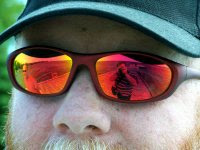A trip down to the waterfront on Friday found a squadron of British war ships. Of course, they were based on the War of 1812, with rigging and sails. The ships included the St Lawrence II, the Faire Jeanne, La Revenante and Caledonian. These ships were recently at the Kingston event, and for this event, were joined by the Toronto Brigantine Ships Playford and Pathfinder, docked together on the waterfront.
Down at H2O beach, the tall ships are lined up aong the dock.
Two sailers walk towards the waiting ships.
Its amazing how much rope is involved in sailing a tall ship.
Which just means that someone has to go up there is there are any problems!
The ships are all part of "The Navy of 1812: Sailors on the Lakes" event, a War of 1812 Bicentennial event. The event took place at Parks Canada's Fort George Historic Site, in Niagara on the Lake.
The Fort was an important site during the war. At the start of the war itself, the americans were actually having dinner at the fort. They finished, and headed back to the US, and for the next 3-4 years they were enemies. And during that time, the US had a series of invasions, and ended up holding the fort for a large part of the war.
Many of the buildings were open, with displays of information on the war, as well as representations of life during the war period. This was the barracks, where the men slept and kept their personal goods.
While one soldier explains how the Brown Bess is loaded and fired, the squad marches into place to do a musket drill.
Also on hand were a British soldiers encampment, and down near the water, a Naval encampment. Between both was a Merchants Area. And many of the merchants build their business on the re-enactors, with knives, muskets and pistols for sale.
While others were selling typical period items like candles and cups.
At miday, the first phase of the demo began, which would see a reproduction of what would be a naval exercise, in which British soldiers would both attack and defend, teaching both the issues involved in attaching and defending a beach head.
The longboats, ready to carry the troops onto the beach.
You can almost imagine a family saying good bye before their father heads off to war.
A Naval Officer on his way to his tall ship.
Soldiers carefully make there way onto the longboats.
as Sailors get ready to sale the longboats.
Naval sailers row hard to deliver the troops to the beach.
Soldiers are advancing up the beach.
Artillery troops watch the tall ships prepare to send troops to the beach.
And then fire at the fleet.
Back at the fort, at the end of the day, there was a ceremony where the flag is lowered, and the troops (inlcuding the band) troop the colours.
Some of the re-enactors were playing Dragoons, with colourful helmets, including an animal skin fur covers.
After the naval event, there was a break in the action, which gave many of the visitors and chance to enjoy the small time charm of Niagara On the Lake. Back during the war, it was known as Newark, and during one of the many US invasions, the US soldiers burned the town down. This changed the "Gentlemens War" quite a bit, and lead to the sacking of Buffalo and of course the famous taking of Washington, where British troops burned the White House!
At 7, the second phase of the demo began. The idea was that the US soldiers would have to hold the fort, as the British troops began an attack to retake the fort.
US Forces try to defend the fort, firing on the advancing british soldiers.
A Dragoon fires back towards the enemy.
A close up of a Dragoon, generally a horse soldier, firing his smaller length musket.
The British, led by their officers, advance into the Fort, firing in volley's to drive the US from the fort.
US soldiers still fight to hold the fort.
The cost of war. As the colours advance, the field is littered with the dead of battle.
A large scale view of the size of the battle that Fort George held. This is one of the larger actions I have seen for War of 1812 events.
A special thanks to Peter Martin of Parks Canada!

No comments:
Post a Comment